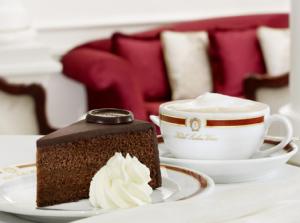I have been following the Guy Fieri/New York Times feud with interest, partly because I’m just as interested as everybody else in finding out what “donkey sauce” is, and partly because that review was harsh enough to maybe, just maybe, merit litigation if the restaurant fails. Fieri is already accusing critic Pete Wells of having “a different agenda” in drafting the review, and “agenda” is really only a few steps away from “malice”. And so it goes, as either Kurt Vonnegut or Billy Joel might say. On the other hand, the review has generated an extraordinary amount of publicity for the place, so perhaps it will thrive.
Wells remarked in his review that Fieri’s menu features “important American food” which should be executed correctly. This was most likely a preemptive response to those who would accuse, and who in fact now have accused, Wells and his ilk of snobbery. It’s a reasonable criticism. The people who will order a giant burger at Fieri’s tourist trap-y place in Times Square are not expecting El Bulli. But Well’s defense is also correct: certain foods become identified with the cultures that birth them (or at least refine them).
Witness the protracted litigation over a Viennese cake.
You are probably familiar with the Sacher Torte. It shows up reliably on dessert menus and in coffee shop display cases here in the United States, sometimes with a small chocolate medallion, sometimes with a stylized letter “S.” For Americans it’s an acquired taste, as the cake tends to be spongier and dryer than what we’re used to.
But in Vienna, the Sascher Torte is a matter of national identity. In 1894, a writer described it as a cake:
distinguished from her companions by wearing beneath her lustrous chocolate gown an undergarment of apricot jam. The Sacher seems destined to preserve the name of its creator in the memory of generations to come, for it is a Viennese specialty, one of those “sweet follies” found in the Imperial city of sweet abandon which, elsewhere, can never be fully replicated. . . . On the tongue, it is pure poetry.
Appetit-Lexikons, 1894 (quoted in Michael Krondl, Sweet Invention: A History of Dessert (Chicago Review Press, 2011)
Legend has it that Franz Sacher invented the cake as a young apprentice in the kitchen of the Viennese imperial chancellor in 1832, although there are reasons not to believe that version of the story. In any event, the cake took off. Sacher’s son, Eduard, ran a hotel that catered to the elite of the belle epoque, and the Sacher Torte featured prominently in its advertising and on its menu. But by the 1930′s the hotel was no longer in top of the line condition and versions of the cake could be had anywhere. The hotel was sold, and the Sacher family sold the rights to the cake, separately, to a well-known Viennese bakery, Demel.
Demel, with the blessing of the Sacher family, sold what you might call the “first” version of the cake. I hesitate to say “original” for the reasons that follow (and because I don’t wish to be sued), but it seems safe to say that Franz Sacher’s version was a one-layer cake. The Hotel Sacher, however, had begun to serve the cake in two layers, with an apricot jam filling in the middle. Both referred to their versions as “the original” Sacher Torte. So as the Nazis entered Vienna, the Hotel Sacher filed suit. And they won, even though by then the nation of Austria had ceased to exist.
Yet the litigation did not end there. In the 1950′s it rekindled, this time because Demel argued that the Hotel’s version could not be original, since Franz Sacher’s cake did not include apricot filling. The fight went on for some seven years. Expert witnesses were called. Appeals were taken to Austria’s Supreme Court. The final ruling permitted the hotel to go on calling its cake “the original” based on the fact that the recipe came from the Sacher family. Demel now calls its cake the “Eduard Sacher Torte”. Both versions bear their names on small chocolate seals affixed to each slice, one in the shape of a circle and the other in the shape of a triangle.

I have been searching for a copy of the Austrian ruling itself with no luck. I would be interested to know whether the court’s refusal to enforce the Sacher family’s assignment of rights to Demel has to do with droit morale, or something along those lines. In many European countries, an artist’s “moral rights” to his or her creation receive protection over and above economic protections and those rights cannot be assigned. Or the court may have had more practical concerns, including the fact that the hotel has based so much of its reputation on the cake that bears its name.
I suspect, for whatever it is worth, that the 136 year old Hotel Sacher does not offer “donkey sauce” on its menu. Guy Fieri, take note.
